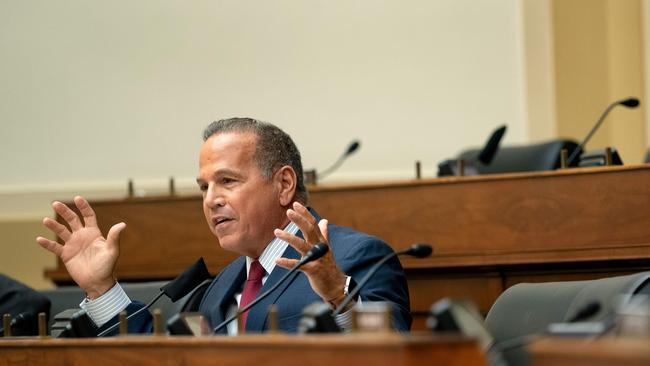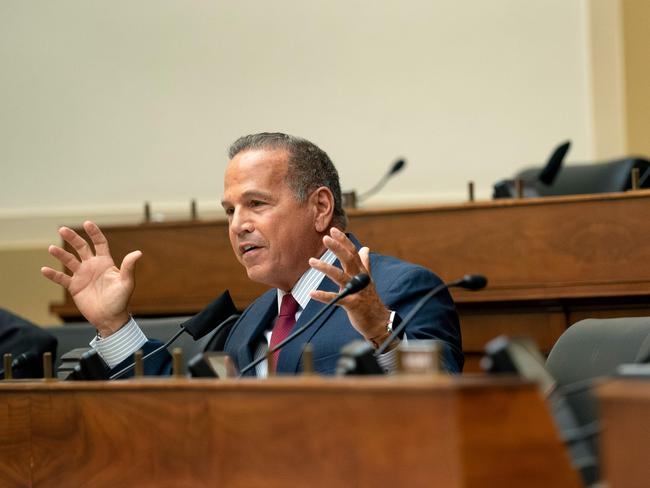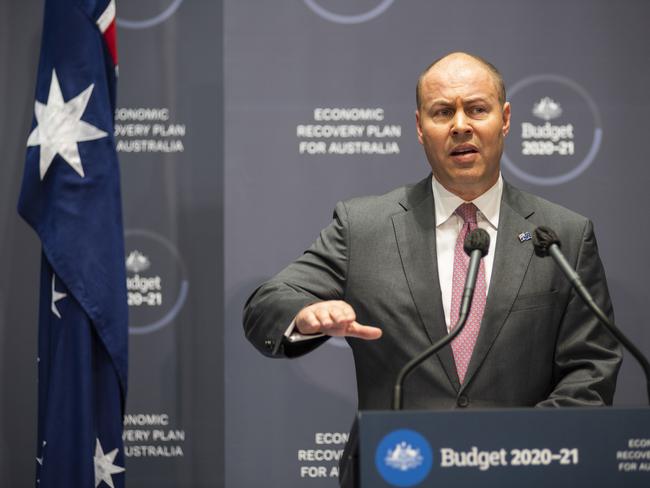Cybersecurity, 5G funding welcomed
Budget commitments to 5G and cybersecurity have been welcomed by tech industry firms.

Hello and welcome to The Download, The Australian’s technology blog for the latest tech news.
Chris Griffith 5.00pm: 5G, cybersecurity commitments welcomed
Commvault has welcomed the budget’s commitment to 5G and says the investment in Australia’s digital future will further accelerate cloud adoption among Australian businesses.
David Rajkovic, Commvault’s area vice president of sales for ANZ, says that with a spike in remote working, there’s an urgent need to harness and protect emerging devices, software and services, while continuing to extract value from existing investments.
“Furthermore, the $29.2 million investment to fast-track the rollout of the 5G network. will provide a platform for Australian businesses to embrace and optimise big data, artificial intelligence and the internet of things,” he says. “Boosting 5G access, will also provide critical connectivity and infrastructure to local enterprises.

“Adopting a cloud-first strategy will be key to take full advantage of a faster 5G network if Australian businesses want to remain competitive on a global scale.
“On the flip side, with an increase in digital connectivity comes an increase in the likelihood of cyberattacks.
“While it’s great to see the government’s significant investments to support Australian businesses access the tools and awareness training required to effectively reduce the risks of cyber threats, the government could have done more to support Australian SMEs if they ever face a cyber-attack.”
“Australian businesses will need to invest funds to ensure their IT systems are secure and protected.”
Rubrik also sees a need for Australian business to invest more in cybersecurity. Jamie Humphrey, ANZ managing director at Rubrik, says Australia becoming a leading digital economy was put on the national agenda with more than $200m earmarked for a new cybersecurity strategy and almost $800m promised as part of the Digital Business Plan.
“This year’s ACSC (Australian Cyber Security Centre) Annual Threat Report warned that ransomware had become one of the most significant threats to both business and government, and that recovering from ransomware was almost impossible without comprehensive backups.
“So, as Australia strives towards the goal of being a digital leader by 2030, I hope there’s a concerted effort to make local businesses – and the local economy – immutable to ransomware.”
3.15pm: Big tech ‘wields monopoly power’
America’s biggest technology companies have leveraged their dominance to stamp out competition and stifle innovation, according to a Democratic-led House panel, which said Congress should consider forcing the tech giants to separate their dominant online platforms from other business lines.
The report released Tuesday from Democratic staff of the House Antitrust Subcommittee capped a 16-month inquiry into the market power of Amazon, Facebook, Google and Apple.

Republicans issued a separate response endorsing strong antitrust enforcement targeting the companies but didn’t endorse many of the Democrats’ policy prescriptions. It also accused the companies of bias against conservative viewpoints.
No legislative changes are imminent, but the report’s sweeping conclusions boost the odds for new laws in the future and publicises evidence that will give momentum to the companies’ critics in both parties.
In one snippet, the report describes an alleged effort by Facebook’s leadership to prevent the company’s Instagram app from competing with the original Facebook platform.
“The question was how do we position Facebook and Instagram to not compete with each other,” the report quotes a former Facebook employee as saying. “If you own two social media utilities, they should not be allowed to shore each other up. It’s unclear to me why this should not be illegal.”
A 2018 memo by Facebook executive Tom Cunningham on the possible “end states” of Facebook’s family of apps concluded that “it is unclear whether Instagram and Facebook can coexist,” the report said, with Mr Cunningham worried about a possible tipping point in which one might come to dominate the other.
“Instagram and WhatsApp have reached new heights of success because Facebook has invested billions in those businesses,” Facebook said in a statement. “A strongly competitive landscape existed at the time of both acquisitions and exists today.”
The company is facing an antitrust investigation by the Federal Trade Commission, which is preparing a potential lawsuit, The Wall Street Journal has reported. Google is also expected to be the subject of an antitrust lawsuit filed by the Justice Department this fall.
Chris Griffith 2.00pm Women’s tech support needs a :Different approach
Co-founder of Aussie proptech start-up :Different says the federal budget didn’t address the systemic problems women face in the technology industry.
The federal government last night announced just under $40m to encourage more women to study STEM (science, technology, engineering and mathematics) subjects. There was $240m for women’s economic security with the government saying it wanted to return women’s participation rate in jobs back to pre-COVID levels.

:Different co-founder Mina Radhakrishnan, however, says the package doesn’t go far enough. “Yesterday’s support package for women is lip service,” she says.
“Unfortunately, it doesn’t shed light on what these initiatives will actually look like, how they will be enforced or how they will solve the real problems women face here.
“I’ve worked in the tech industry in Australia and in San Francisco for a long time and what I have seen is that it’s not just a pipeline problem,” says Ms Radhakrishnan. “Women choose to leave the tech industry because it can be a toxic environment, riddled with pay gaps and a lack of opportunity to advance, often due to a lack of diverse leadership.
“More importantly, framing the problem as purely a gender issue is problematic. The people who suffer most are lower paid workers and minorities, not just women, and the pandemic highlights that.”
She says the government should stop perpetuating the myth that lack of diversity in technology is a “pipeline problem”.
She says it should increase funding to under-represented minorities (not just women) for STEM programs through scholarships and outreach, reward companies that hire diversely and create supportive environments for their team. It should require corporations to publish their leadership and salary statistics, including comparison of pay across gender/race for roles at the same level.
Chris Griffith 10.25am Firm welcomes jobs but questions age 35 cap on tech training support
The tech community has welcomed the $2 billion allocated to the R & D tax incentive in the federal budget, and the removal of $4 million refunds cap. But there are questions about the 35-year cap on support for training technology employees.
Ian Yip, CEO of Avertro, says the government is sending a strong message of support for innovation to the start-up community in particular. “It helps justify our continued focus on R & D, and could result in an increase in effort allocated to innovation which helps strengthen our longer-term strategic initiatives.”
But he says the budget should have gone further in supporting the training of entry-level technology employees.
“While I‘m glad we received this in the form of the JobMaker hiring credit, the budget should have gone further,” he says. “The age restriction to people 35 and under is not inclusive enough. People of all ages were affected as a result of the pandemic, and I for one value the experience those over the age of 35 can bring to any role, even if it’s not in their area of expertise.

“The additional restriction placed on individuals is also problematic; not every unemployed person qualifies for JobSeeker, Youth Allowance or Parenting Payment,” says Mr Yip. “The practicalities of the hiring process in this instance are awkward. It is not always appropriate or relevant to the role when interviewing a candidate to ask if they are currently on one of the forms of government support in question.
“ How can employers actively seek out the people most in need of a job and covered by JobMaker?”
Antoine Acklin, head of architecture & professional services APJ, Rackspace Technology, welcomed the jobs investment as applied to technology. “The Treasurer has stated that this budget is ‘all about jobs’,” he says. “The over $2.1bn allocated for investments in cybersecurity and law enforcement has not only opened the door for newer technology to enable better protection, but it presents an opportunity to create a more balanced workforce to support it.
“The investment in apprenticeships may deliver quite an interesting response to securing skilled workers within cybersecurity. This can provide Australia with a sustainable workforce to grow its expertise, solutions and services in emerging technologies and power the platforms that facilitate our protection.
“It is expected both private and public sectors will quickly introduce programs that recruit, groom and promote talent in the areas of AI, ML and IoT. “
CrowdStrike meanwhile says it is pleased to see the government acknowledge the risks associated with having outdated digital infrastructure.
Andrew Littleproud, CrowdStrike’s vice president Asia Pacific and Japan, says it recently conducted research which found over half of Australian business leaders believe that cybersecurity is the top priority for additional investment, and that despite a grim economic outlook, two in five expect their technology budgets to increase.
“It is our hope that this substantial investment from the government will encourage further collaboration between government and the broader technology community to ensure Australian businesses are investing wisely, and transitioning into the digital economy with industry-leading technologies that will boost business operations and strengthen security and risk protocols.”
Greg Moshal, CEO of Prospa, welcomed the government’s decision to back-pedal on earlier plans to scrap research and development incentives and offer additional support. “Today’s decision will further encourage Australia’s world class technology companies to innovate and grow and play a pivotal role in driving Australia’s economic recovery.”
Chris Griffith 9.55am Warning on more funding for facial recognition technology
The government and community should be circumspect about the increased use of digital identity checks for individuals and businesses.
Associate Professor Uri Gal from The University of Sydney Business School says the government has announced it will expand its use of digital identity checks for individuals and businesses who wish to access online services.

“The digital identity program – funded through $257m – is meant to simplify and lower the costs of interacting with government services, and, in the future, the private sector,” Assoc Prod Gal says. “This funding includes boosting facial recognition capabilities.”
But he says facial recognition technologies have raised privacy concerns worldwide. “Unlike other identification methods (such as passwords), our facial data is unique, intimately personal, and mostly unchangeable. Therefore, the use of facial recognition technologies can add another dimension of data harvesting and surveillance that is particularly acute.
“Moreover, despite the promise of enhanced security and efficiency, facial recognition technologies are notoriously unreliable and prone to error. For instance, they have been shown to be both skin-tone and gender biased and lead to false arrests.
Chris Griffith 9.05am BMW Group welcomes incentives for electric car fleets
BMW Group Australia says the government’s financial package to encourage businesses to trial new technologies will mark a “line in the sand” for manufacturers and supercharge the local market’s adoption of electrified vehicles.
The government announced a $74.5 million “Future Fuels Fund” to help business and regional communities take advantage of opportunities offered by hydrogen, electric, and bio-fuelled vehicles, and enable infrastructure for the growth of commercial electric vehicles.
BMW Group says it has created a tailored program for small to medium enterprises seeking to purchase a new BMW or MINI electric vehicle with a $1500 incentive for new vehicle purchases for company use. This is equivalent to the charging cost for up to 30,000km of travel in a BMW electric vehicle.
Vikram Pawah, CEO of BMW Group Australia, says the incentives should act as the catalyst for local market growth and help Australia bridge the gap with high uptake markets in Europe, North America and Asia.
“For BMW Group, investing in electro-mobility technology development for business should be a given in Australia,” he says. “Countries such as the USA, Norway and China have all invested in a strong charging network and offered monetary incentives to both commercial and private buyers of plug-in hybrid or fully electric vehicles, leading to high uptake across the board in these markets.
“However, the cost benefit of electrified vehicles is just one of the challenges facing uptake in Australia. Sustainable alternatives to electric vehicles are also in the dark, meaning concerns such as range anxiety are present among local buyers despite viable options such as plug-in hybrid electric vehicles (PHEV) readily available in the market.
“For example, the MINI Electric has a driving range of 233km on a single charge and the same single charge endows the BMW i3 provides a range of up to 260km in daily use – both well exceeding the 36km driven by the average Australian every day.”
Mr Pawah says the government has an important role to play in influencing public mindset about the vast benefits of electrified vehicles.
Chris Griffith 7.50am Tech firms welcome budget digital investment
Technology businesses have rallied behind the Federal Government’s plans for helping businesses go digital. The government had pre-announced $800m to digitise business interaction with government with measures such as electronic invoicing, an expansion of the Digital Identity Program and the streamlining across government of business registers.
“One of the biggest trends is to invest in technology that drives automation, not to remove the need for people, but as a tool to standardise, grow and free up employees’ time to focus on customers and growth – it’s a win-win for all,” says Christian Lucarelli, vice president sales, Asia Pacific, Nintex.
Business in particular sees the ability to instantly write-off newly purchased assets as helping them modernise and be less susceptible to cyberattacks. The new plan places a cap on purchases of $150,000 and a deadline of June 2022.

Mark Sinclair, ANZ regional director, WatchGuard Technologies, says the measure will support Australian companies and businesses obtain the technology and awareness training required for effective mitigation of modern cyberthreats. “In turn, this will also help drive more jobs in the local cyber security industry and is a recipe that the Morrison government should consider for future stimulus packages.”
Jane Livesey, CEO for Cognizant ANZ, says the instant asset write-off is the budget’s biggest spend item amounting to $26.7bn and gives Australian enterprises the opportunity to make the necessary investments, “a significant portion of which, we believe, will future-enable enterprises to automate and digitise their businesses, whether that be fleet modernisation or production line improvements”.
“Personally, I am concerned about the progress we are making in boosting employment for women. COVID-19 has been a significant setback, and having investment specifically targeted towards women in STEM is positive to see, as we encourage more women to embark on careers in technology.”
Chris Marshall, Managing Director blueAPACHE, says the government’s investment in technology will accelerate cloud adoption among businesses. “Right now, with workforces distributed, there‘s an urgent need to harness emerging devices, software and services while at the same time extracting maximum value from existing investments,” he says. “Gone are the days where an organisation’s IT department could design and build systems based on clear, five-year plans.”
Pieter DeGunst, managing director, Tecala, says the investment into systems and processes to operate from anywhere at anytime will revolutionise our abilities to access talent across Australia and compete globally.
Budd Ilic, ANZ country manager, Zscaler, says a part of the government’s investment will involve retiring legacy technologies and migrating to cloud based systems that allow companies to be more agile and productive. ““It is imperative that the government ensures robust and consistent investment in providing protection across all departments and agencies irrespective of size. “
Michel Steckler, CEO, Tradify, says inefficient systems and processes mean many trade business owners are spending hundreds of hours a year on paperwork that could be better spent on the tools. “New government support should help tradies take advantage of the post-COVID boom by investing in tools that will help them work smarter and put them in a better position to make the most of new business opportunities ahead as the economy opens up. “
Glen Maloney, ANZ Regional Sales Manager, ExtraHop, says it is easier to ensure profitability and keep customers happy when managers are equipped with information that is secure, accurate and available in real time. “With the potential for greater automation and digitisation, business owners and managers will now have enhanced ability to make informed decisions the moment issues or changes are identified.”
Joanne Wong, vice president International Marketing APAC, LogRhythm, says the government’s zeal should spur company management within businesses of all sizes grappling with a remote workforce and uncertain market conditions to take a proactive approach and review their cyber security hygiene. “This will benefit employees and customers of organisations who will want to know that management have the latest technology in place which can detect threats and help quickly remediate attempted attacks if they do happen.”
Daniel Harding, Director – Australia Operations, MaxContact says the pandemic has reinforced the importance of the role played by contact centres, particularly during times of uncertainty. “This budget and its emphasis in fuelling investment in automation and digitisation provides Australian businesses with an incentive to invest in improving the omni-channel experience which should now be an imperative for Australian organisations which are serious about improving the quality of the customer experience they deliver.”
Jim Cook, ANZ managing director, Attivo Networks, says the firm’s experience shows that while many large Australian enterprises still lack a comprehensive approach to detecting and combating threats, they need to face the reality that motivated hackers don’t take a holiday. “The support for businesses of all sizes in this budget should encourage management to review their overall IT and cyber security strategy and take a hard look at the potential implementation of modern technologies which can combat attackers and reduce the chance of customers suffering loss of privacy and identity.”
Mark Perry, chief technology officer Asia Pacific, Ping Identity welcomed the funding to support the rollout of the Consumer Data Right (CDR) to banking and energy. “We anticipate this will assist in streamlining the onboarding process for data recipients, which is currently limiting the expansion of the program,” he says. “It is also hoped that this will fund the release of a complete testing suite to solution vendors, to provide Data Holders and Data Recipients with confidence as they make important technology decisions for CDR compliance.”



To join the conversation, please log in. Don't have an account? Register
Join the conversation, you are commenting as Logout